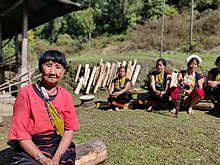
Back شعب آدي Arabic Adis Catalan قوم ادی Persian Adi (peuple d'Asie) French આદી જ્ઞાતિ Gujarati आदी लोग Hindi ആദി Malayalam आदी जनजाती (अरुणाचल प्रदेश) Marathi Adis Portuguese Ади (народ) Russian
 An elderly Adi women from Arunachal Pradesh singing a folk song | |
| Regions with significant populations | |
|---|---|
| N/A | |
| Arunachal Pradesh | N/A |
| N/A | |
| Tibet Autonomous Region | N/A |
| Languages | |
| Tani | |
| Religion | |
| Majority: Donyi-Polo Minority: Christianity, Buddhism | |
| Related ethnic groups | |
| Tani people, Lhoba people | |
The Adi people are one of the most populous groups of indigenous peoples in the Indian state of Arunachal Pradesh. A few thousand are also found in the Tibet Autonomous Region, where they are called the Lhoba together with some of the Nyishi people, Na people, Mishmi people and Tagin people.
They live in a region of the Southern Himalayas which falls within the Indian state of Arunachal Pradesh and the Mainling, Lhunze, Zayu, Medog, and Nyingchi counties in the Tibet Autonomous Region, China. The present habitat of the Adi people is heavily influenced by the historic location of the ancient Lhoyu. They are found in the temperate and sub-tropical regions within the districts of Siang, East Siang, Upper Siang, West Siang, Lower Dibang Valley, Lohit, Shi Yomi and Namsai within Arunachal Pradesh. The term "Adi" however, is not to be confused with the Lhoba people, since the Lhoba also includes the Mishmi along with the Adi people. All the ethnic groups recognizing themselves as "Adi" are believed to be descendants of the Abutani/Abotani. The older term Abor is an exonym from Assamese and its literal meaning is "independent". The literal meaning of adi is "hill" or "mountain top".